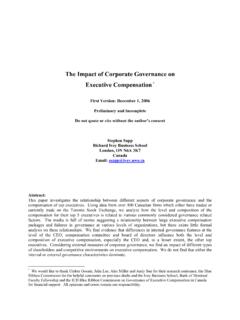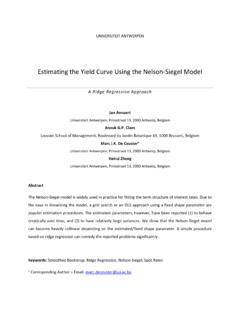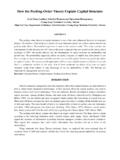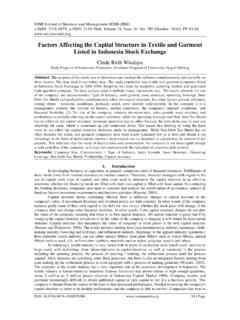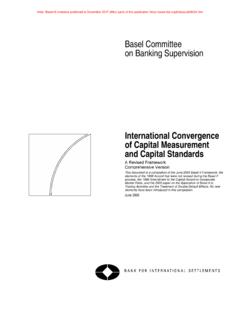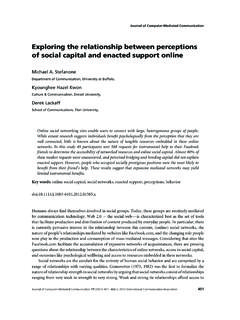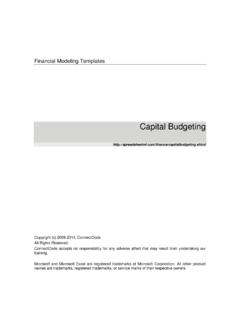Transcription of R&D Investment and Capital Structure - EFMA
1 R&D Investment and Capital Structure * Huili Chang and Frank M. Song January 2014 Abstract It is well known that innovative firms tend to issue equity for external finance, but no one has attempted to differentiate whether this is due to financial frictions from the supply side of Capital or is voluntarily chosen by firms given that the policy implications are quite different. This paper tries to fill this gap. We first confirm that firms with high R&D Investment issue more equity and less debt, have a lower leverage, and tend to become zero-leverage. We also use the introduction of state-level R&D tax credits in the US as an exogenous event to establish the causality. Then we examine corporate financing decisions after firms are granted patents.
2 We find that firms with more favorable patent characteristics issue less debt and more equity, and have a lower leverage. Because patents can reduce information asymmetry associated with R&D Investment and be used as collateral, firms tendency to issue equity after credit constraints are partially relaxed shows that frictions from the supply side of Capital are not the critical reason for innovative firms to issue equity. Innovative firms may find that equity is conducive to innovation so that they choose to issue equity. JEL Classification: G31, G32 Keyword: R&D Investment , Financing Choice, Leverage * EFM classification code: 140. We would like to thank Paul Po-Hsuan Hsu, Matt Keloharju, and Jayant R.
3 Kale for their helpful comments. Will attend the conference and present the paper. School of Economics and Finance, The University of Hong Kong. Phone: (852) 6571-5825. Email: School of Economics and Finance, The University of Hong Kong. Phone: (852) 2857-8507. Email: 1 1. Introduction The irrelevance theory proposed by the seminal paper of Modigliani and Miller (1958) implies that corporate Investment and financing are completely separable decisions in perfect Capital markets. Not surprisingly, subsequent papers document that corporate Investment and financing activities are closely related after relaxing some of their assumptions. On one hand, high external financing cost will reduce corporate Investment , which is the focus of the financial constraints literature1, and each financing security has its pros and cons in terms of corporate Investment .
4 For instance, debt can mitigate the free cash flow problem pointed out by Jensen (1986) that managers tend to do empire building, but can also cause the overhang problem discussed in Myers (1977) that it is more difficult for firms with higher debt level to raise funds for new growth opportunities. On the other hand, corporate Investment can also affect corporate financing decisions. Mauer and Triantis (1994) show that high production flexibility can enhance a firm s debt capacity while the impact of financial flexibility on Investment is negligible. Tsyplakov (2008) demonstrates that Investment frictions can explain the observed leverages. Furthermore, the results of corporate Investment , like corporate profitability, asset volatility and tangible assets ratio are important determinants of corporate leverage.
5 As one of the most important activities for a firm s survival, R&D Investment is commonly believed to associate with lower leverage after Bradley, Jarrell and Kim (1984) and Titman and Wessels (1988). There are mainly two strands of reasons given. First, because of debt overhang, firms themselves choose equity over debt when financing R&D Investment . 1 See Hubbard (1998) and Stein (2003) for a summary of the literature. 2 This is considered from the perspective of firms, , the demand side of Capital . The other is considered from the borrowers point of view, , the supply side of Capital . R&D Investment is very risky and cannot generate tangible assets that are commonly used as collaterals. As a result, firms with high R&D Investment are unable to borrow even though they would if debt is available.
6 These two strands of reasons can have quite different policy implications. If the demand side is true, policy maker should take measures to facilitate the development of equity market. Otherwise, more incentives should be given to borrowers to lend to the innovative firms. Nevertheless, no paper has attempted to disentangle these two sides so far, and this paper tries to fill this gap. To lay out the foundation for analysis, we first examine the relationship between R&D Investment and corporate Capital Structure . As for corporate Capital Structure , we analyze both the incremental financing choices and the cumulative leverage level. We employ the multinomial logistic regression to analyze firms choice among internal funds, equity and debt, and logistic regression between equity and debt conditional on external issuance as in Hovakimian, Opler, and Titman (2001) and Chang, Dasgupta and Hilary (2006).
7 Then we use the pooled OLS regression to analyze the determinants of corporate leverage. Specifically, we use lagged R&D Investment to explain the incremental financing choice, and R&D Capital , constructed using the perpetual inventory method similar to tangible assets, to explain firm leverage. Besides, we also use the logistic regression to link R&D Capital to the probability of having zero leverage as an extreme case of leverage. Consistent with prior literature, the regression results show that firms with high R&D Investment tend to issue equity, and firms with high R&D Capital have a low leverage and a high probability of using zero debt. Since 3 financial constraints are an important factor that can affect financing choice (Chang and Song, 2013), we also run the regression separately for financially constrained and unconstrained firms, and find that constrained firms do use more equity issues to finance R&D while unconstrained firms do not.
8 But the negative relation between R&D Capital and leverage is the same for both constrained and unconstrained firms, which means that financial constraints cannot explain the effects of R&D Investment . This paper also uses the introduction of state-level R&D tax credits as an exogenous shock to establish the causality from high R&D Investment to low leverage. Wilson (2009) finds that state R&D tax credits are effective at increasing R&D within the state, and R&D tax credits are unlikely to correlate with other variables rather than R&D Investment that may affect corporate financing decisions. Thus the introduction of state-level R&D tax credits satisfies the relevance and exclusiveness conditions of an exogenous shock. We find that after the introduction of state R&D tax credits, firms headquartered in that state tend to issue less debt and more equity, have lower leverage, and have a larger probability of becoming a zero-leverage firm.
9 To differentiate the supply side effect from the demand side effect, we analyze firms financing decisions after being granted patents. Patents are outputs of R&D Investment and are publicly announced after being granted so that they can alleviate the information asymmetry problem concerning R&D. Loumioti (2012) suggests that the proportion of secured syndicated loans that are collateralized by intangible assets (mostly patents) has been steadily increasing since the mid-1990s. If firms are forced to issue equity due to financial frictions from the supply side, we should expect they use more debt and have higher leverage 4 after being granted patents, in particular firms with more patents, more influential patents, and higher innovation efficiency.
10 First, we examine the relationship between patents and firms incremental financing choices. After controlling for R&D Investment in the regression, we find that firms with more patents and with higher innovation efficiency tend to use less debt in the next fiscal year, firms with higher citations tend to use more equity, while the results for firms with higher generality or originality scores are insignificant. Next, we examine the relationship between patents and firm leverage as the cumulative results. We find a consistently negative relationship for firms with more patents, with higher citations, with higher generality or originality scores, and with higher innovation efficiency. These empirical results indicate that even though the frictions from the supply side of Capital may be mitigated, firms use more equity financing after being granted patents.

